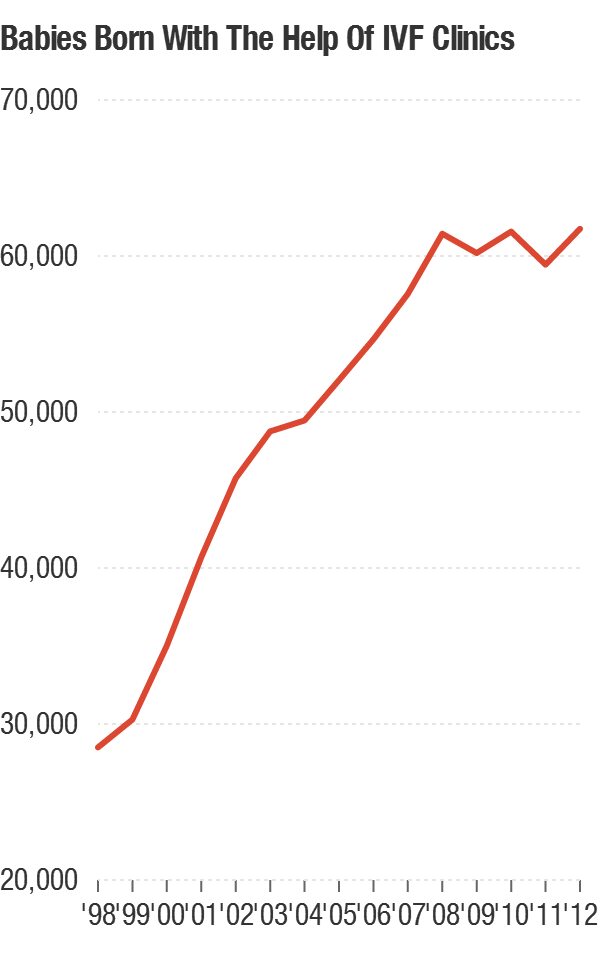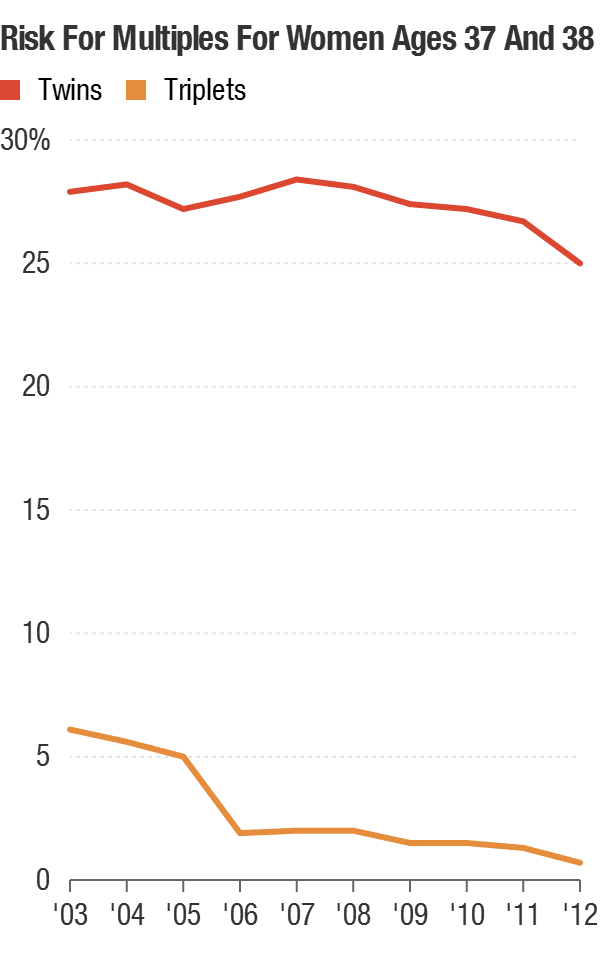In 2012, More Than 61000 Ivf Babies We Born in the Us

Sperm are placed inside the egg with a needle during a fertility treatment called intracytoplasmic sperm injection. iStockphoto hide caption
toggle caption
iStockphoto

Sperm are placed inside the egg with a needle during a fertility treatment called intracytoplasmic sperm injection.
iStockphoto

Values include babies conceived through in vitro fertilization and other fertility treatments at IVF clinics. Michaeleen Doucleff/NPR/Data from Centers for Disease Control and Prevention hide caption
toggle caption
Michaeleen Doucleff/NPR/Data from Centers for Disease Control and Prevention

Values include babies conceived through in vitro fertilization and other fertility treatments at IVF clinics.
Michaeleen Doucleff/NPR/Data from Centers for Disease Control and Prevention

The rate of triplets has dropped for babies conceived by in vitro fertilization. But the chance for twins is still high for women under age 40. Michaeleen Doucleff/NPR/Data from the Centers for Disease Control and Prevention hide caption
toggle caption
Michaeleen Doucleff/NPR/Data from the Centers for Disease Control and Prevention

The rate of triplets has dropped for babies conceived by in vitro fertilization. But the chance for twins is still high for women under age 40.
Michaeleen Doucleff/NPR/Data from the Centers for Disease Control and Prevention
More couples than ever are turning to in vitro fertilization to help build families.
In 2012, more than 61,000 babies were conceived with the help of IVF, the Society for Assisted Reproductive Technology reported Monday.
That means IVF babies made up 1.5 percent of the 3.9 million births in the U.S, the agency wrote on its website. And it makes 2012 the biggest year for IVF on record: Doctors performed the most procedures and delivered the most IVF babies.
Over the past decade, the number of IVF treatments has been rising. Doctors performed about 113,000 cycles back in 2003. That number jumped by nearly 50 percent to about 165,000 in 2012.
"A lot of individuals — specifically women — are choosing to develop their careers, and they're having great opportunities, " says Charles Coddington III, an OB-GYN at the Mayo Clinic in Rochester and president of SART. "So a lot of them are getting older before they have children, and they are needing more IVF services."
At the same time, the number of high-risk multiple births from the treatment have been slowly declining, the report found.
"If we dig deeper into the data, there has been a marked reduction in triplets," Coddington tells Shots. "Everyone is really attuned to reducing triplets."
In 2003, women between the ages of 35 and 40 had about a 6 percent chance of having triplets during a successful IVF procedure. Now the odds have dropped to 0.7 percent.
The reason for the decline, Coddington says, is that couples and their doctors are choosing to use fewer embryos during each cycle. "It isn't across the board," Coddington says. "There are still outliers. But the trend is really good. So we've had a better year in terms of triplets."
The chance for twins is also less than it was a decade ago. But the rate is still high, especially for women younger than 40. About a quarter of all successful IVF cycles for women in this age group resulted in twins during 2012, the study reported.
The problem with twins and triplets, Coddington says, is that they raise the health risks for both moms and babies.
Twins are delivered about a month early, on average, he tells Shots. "So about a third of them are going to be in the neonatal nursery. Many will require close observation and have to be put on ventilation."
Mothers pregnant with twins and triplets have higher risks for diabetes, Cesarean sections and a form of hypertension called preeclampsia, Coddington says. "Pregnancy is the toughest elective stress that women will put on their body," he says. "We think it's a simple as, 'Boom! You're pregnant.' But there's a lot of things that can happen."
Between 1971 and 2011, the rate of multiple births doubled in the U.S., from 1.8 to 3.5 percent, a study published in December found. That spike has been almost entirely because of fertility treatments.
In the past, doctors often used three or more embryos during IVF to boost the chance of pregnancy, especially in older moms.
But two years ago, a study in England found that transferring more than two embryos didn't actually increase the odds for a successful live birth. And the average number of embyros transferred per cycle has been steadily declining in all age group groups over the past decade.
For instance, the average number of embryos used for women between the ages of 35 and 37 dropped from 2.9 in 2003 to 2.0 in 2012, the study found.
In fact, IVF is no long the the top culprit for high-risk multiple births. Instead, fertility drugs, such as Clomid, are, a study found.
But IVF does come with other risks. During the procedure, 1 to 5 percent of women suffer from a potentially serious complication, called ovarian hyperstimulation syndrome. IVF babies conceived by a special fertilization technique called ICSI have a small increase in risk for a few rare genetic disorders, including Beckwit-Widemann syndrome and Angelman syndrome.
In the U.S., each IVF cycle costs about $12,400, on average. The overall chance for a baby is about 1 in 3. But the odds depends largely on the age of the women. For those under age 35, success rates are more than 40 percent. Above age 42, chances fall to about 10 percent per cycle.
In 2012, More Than 61000 Ivf Babies We Born in the Us
Source: https://www.npr.org/sections/health-shots/2014/02/18/279035110/ivf-baby-boom-births-from-fertility-procedure-hit-new-high
0 Response to "In 2012, More Than 61000 Ivf Babies We Born in the Us"
Post a Comment